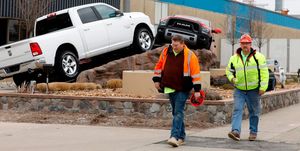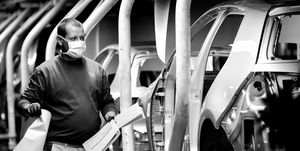- Ford has revealed an ambitious safety protocol aimed at gradually reopening its 78 Ford or joint-venture plants and 11 engineering centers around the world in the coming weeks and months.
- While not stating an exact date for a full reopening, the company said it would begin with a May 4 return in European facilities and move into U.S. and other locations after that.
- Ford says five conditions must be met before any restart: government support, location-specific modeling approved by academic and health experts, workspace safety rules in place, a staggered return schedule that focuses on employee safety, and a learning and communication setup so employees are prepared.
After planning and then postponing a return to vehicle production in early April, Ford is now revealing a detailed “playbook” of safety precautions to enable a gradual return to work at its facilities worldwide over the coming weeks and months.
The automaker, like its other Detroit Three counterparts, had shut down auto production in mid-March as the coronavirus pandemic spread through Michigan and other U.S. states. Along with those other companies and other automakers worldwide, it has announced and then changed plans to reopen facilities as the pandemic continues.
The Detroit Free Press reported earlier this week, quoting Ford manufacturing and communications manager Kelli Felker, that Ford intends to have workers “begin putting safety protocols in place” in some facilities. These employees would not be required to go to work if they felt unsafe, the paper reported. What plants will reopen for production, and when, has not yet been announced.
The United Auto Workers union issued a statement earlier this week expressing pride in the “brave UAW Ford, FCA, and GM men and women who have stepped up and agreed to serve as paid volunteers” to get the plants ready to reopen. UAW president Rory Gamble also emphasized that the union believes it is “simply too risky to consider” restarting in early May.
Ford provided a list of five conditions for reopening any facility. These include: partnering with governments; location-specific modeling of the situation supported by the World Health Organization and the Centers for Disease Control and Prevention, among other experts; a set of core safety rules in place, including temperature scanning, providing personal protective equipment (PPE), and modifying facility layouts to ensure social distancing; training employees so they can transition smoothly to the new situation at work; and a staggered, “employees-centric” schedule to return the facility to operation gradually.
This kind of playbook is not unique to Ford. Volkswagen earlier this week revealed its 100-point safety plan, which it is using already to restart production at facilities in Germany.
Source: Motor - aranddriver.com






